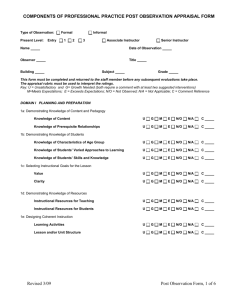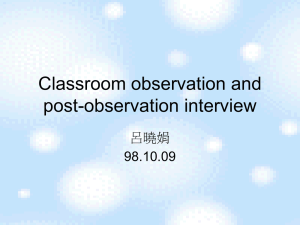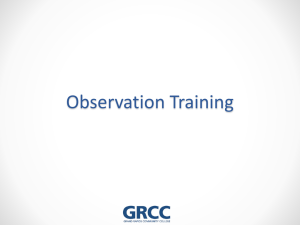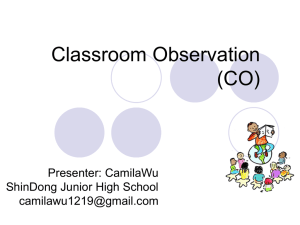Classroom Observations: Teacher Driven Classroom observations
advertisement
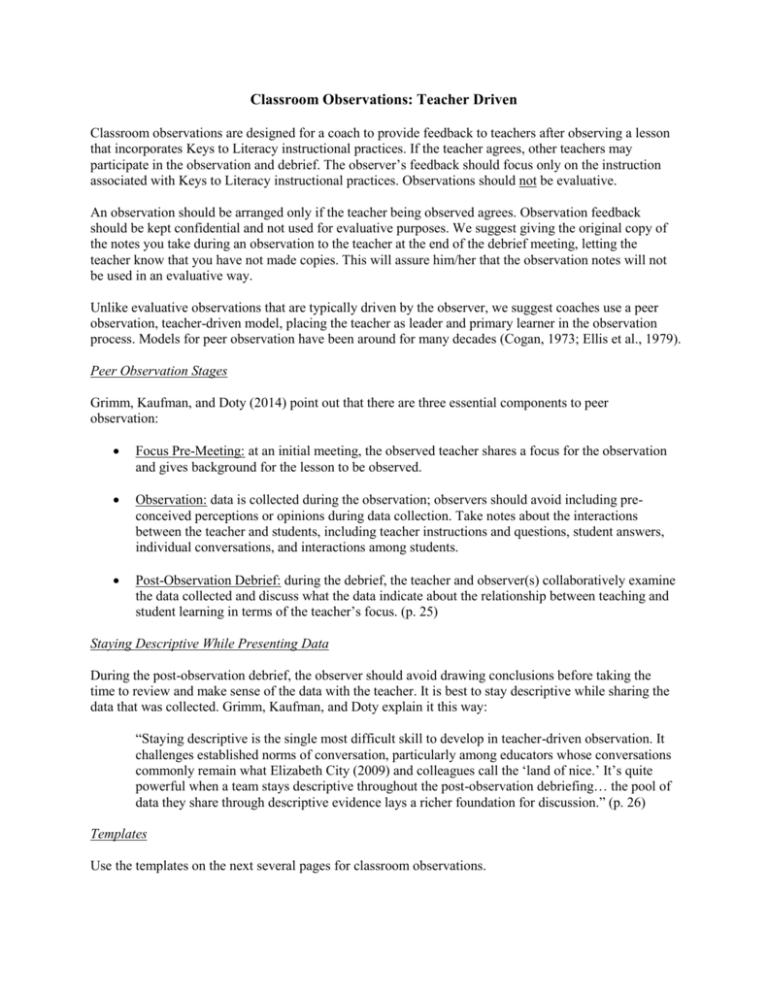
Classroom Observations: Teacher Driven Classroom observations are designed for a coach to provide feedback to teachers after observing a lesson that incorporates Keys to Literacy instructional practices. If the teacher agrees, other teachers may participate in the observation and debrief. The observer’s feedback should focus only on the instruction associated with Keys to Literacy instructional practices. Observations should not be evaluative. An observation should be arranged only if the teacher being observed agrees. Observation feedback should be kept confidential and not used for evaluative purposes. We suggest giving the original copy of the notes you take during an observation to the teacher at the end of the debrief meeting, letting the teacher know that you have not made copies. This will assure him/her that the observation notes will not be used in an evaluative way. Unlike evaluative observations that are typically driven by the observer, we suggest coaches use a peer observation, teacher-driven model, placing the teacher as leader and primary learner in the observation process. Models for peer observation have been around for many decades (Cogan, 1973; Ellis et al., 1979). Peer Observation Stages Grimm, Kaufman, and Doty (2014) point out that there are three essential components to peer observation: Focus Pre-Meeting: at an initial meeting, the observed teacher shares a focus for the observation and gives background for the lesson to be observed. Observation: data is collected during the observation; observers should avoid including preconceived perceptions or opinions during data collection. Take notes about the interactions between the teacher and students, including teacher instructions and questions, student answers, individual conversations, and interactions among students. Post-Observation Debrief: during the debrief, the teacher and observer(s) collaboratively examine the data collected and discuss what the data indicate about the relationship between teaching and student learning in terms of the teacher’s focus. (p. 25) Staying Descriptive While Presenting Data During the post-observation debrief, the observer should avoid drawing conclusions before taking the time to review and make sense of the data with the teacher. It is best to stay descriptive while sharing the data that was collected. Grimm, Kaufman, and Doty explain it this way: “Staying descriptive is the single most difficult skill to develop in teacher-driven observation. It challenges established norms of conversation, particularly among educators whose conversations commonly remain what Elizabeth City (2009) and colleagues call the ‘land of nice.’ It’s quite powerful when a team stays descriptive throughout the post-observation debriefing… the pool of data they share through descriptive evidence lays a richer foundation for discussion.” (p. 26) Templates Use the templates on the next several pages for classroom observations. Planning A Classroom Observation Notes from pre-observation meeting between teacher and coach: Which instructional practice(s) from Keys to Literacy will be the focus for the observation? Brief description of the lesson plan and goals for the lesson: Is there something specific the teacher would like the coach to focus on? Notes from post-observation debrief meeting between teacher and coach: Based on the observation data presented, what is the teacher’s impression about how the lesson was executed? Does the teacher think the lesson goals were met? What questions does the teacher have for the coach? Action steps: What can the coach do to provide continued support of the teacher? Key Comprehension Routine Observation Notes Date: ______________________ Observer: _____________________________________________ Teacher, Subject, Period Observed: ___________________________________________________ Instructional practice(s) observed: ___Main Idea Skills ___Top-Down Topic Web ___Two Column Notes ___Summarizing ___Question Generation OBSERVATIONS ______________________________________________________________________________ COMMENTS/QUESTIONS Key Comprehension Routine Observation Notes Date: ______________________ Observer: _____________________________________________ Teacher, Subject, Period Observed: ___________________________________________________ Instructional practice(s) observed: ___Main Idea Skills ___Top-Down Topic Web ___Two Column Notes ___Summarizing ___Question Generation What the teacher is doing What the students are doing Evidence of gradual release of responsibility (I, We, You) Key Vocabulary Routine Observation Notes Date: ______________________ Observer: _____________________________________________ Teacher, Subject, Period Observed: ___________________________________________________ Instructional practice(s) observed: ___Previewing Words ___Frayer, Concept Def Map, 2-Column ___Connection Activities (Semantic Mapping, Semantic Feature Analysis, Categorizing, Scaling) ___ User Friendly Definitions ___Use of Content ___Use of Word Parts ___Top-Down Topic Webs ___WAG OBSERVATIONS ______________________________________________________________________________ COMMENTS/QUESTIONS Key Vocabulary Routine Observation Notes Date: ______________________ Observer: _____________________________________________ Teacher, Subject, Period Observed: ___________________________________________________ Instructional practice(s) observed: ___Previewing Words ___Frayer, Concept Def Map, 2-Column ___Connection Activities (Semantic Mapping, Semantic Feature Analysis, Categorizing, Scaling) ___ User Friendly Definitions ___Use of Content ___Use of Word Parts ___Top-Down Topic Webs ___WAG What the teacher is doing What the students are doing Evidence of gradual release of responsibility (I, We, You) Keys to Content Writing Observation Notes Date: ______________________ Observer: _____________________________________________ Teacher, Subject, Period Observed: ___________________________________________________ Instructional practice(s) observed: ___Quick Write ___Writing Process ___3 Types of Writing ___Basic Text Structures ___Two-Column Notes ___Top-Down Topic Webs ___WAG OBSERVATIONS ______________________________________________________________________________ COMMENTS/QUESTIONS Keys to Content Writing Observation Notes Date: ______________________ Observer: _____________________________________________ Teacher, Subject, Period Observed: ___________________________________________________ Instructional practice(s) observed: ___Quick Write ___Writing Process ___3 Types of Writing ___Basic Text Structures ___Two-Column Notes ___Top-Down Topic Webs ___WAG What the teacher is doing What the students are doing Evidence of gradual release of responsibility (I, We, You)
